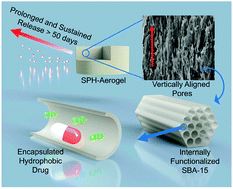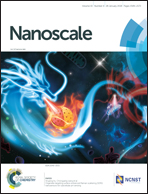Multifunctional hybrid aerogels: hyperbranched polymer-trapped mesoporous silica nanoparticles for sustained and prolonged drug release†
Abstract
In this study, we show the synthesis of novel hybrid organic–inorganic aerogel materials with one-dimensionally aligned pores and demonstrate their use as sustained and prolonged release systems for a hydrophobic drug. The materials are synthesized by trapping mesoporous silica nanoparticles within a hyperbranched polymer network made from poly(vinyl alcohol) (PVA) and poly(acrylic acid) (PAA). The synthetic method involves dispersing mesoporous silica nanoparticles in a polymer solution, then freeze-drying the solution, and finally subjecting the resulting materials to high temperature to activate a solid-state condensation reaction between PVA and PAA. Before trapping the mesoporous silica nanoparticles within the hyperbranched polymeric network, their pores are decorated with hydrophobic groups so that they can serve as good host materials for hydrophobic drugs. The potential application of the hybrid aerogels as drug carriers is demonstrated using the hydrophobic, anti-inflammatory agent dexamethasone (DEX) as a model drug. Due to their hydrophobic pores, the hybrid aerogels show excellent drug loading capacity for DEX, with an encapsulation efficiency higher than 75%. Furthermore, the release pattern of the payloads of DEX encapsulated in the aerogels is highly tailorable (i.e., it can be made faster or slower, as needed) simply by varying the PVA-to-PAA weight ratio in the precursors, and thus the 3-dimensional (3-D) structures of the cross-linked polymers in them. The materials also show sustained drug release, for over 50 days or more. In addition, the aerogels are biocompatible, as demonstrated with Vero cells, and greatly promote the cell proliferation of L929 fibroblasts. Also, the nanoparticles functionalized with quaternary groups and dispersed within the aerogels display bactericidal activity against E. coli, S. aureus, B. subtilis, and P. aeruginosa. These new hybrid aerogels can, thus, be highly appealing biomaterials for sustained and prolonged drug release, such as wound dressing systems.



 Please wait while we load your content...
Please wait while we load your content...